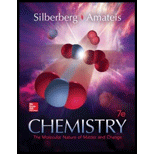
Interpretation:
The metal and non-metal formed at electrodes of
Concept Introduction:
An
Galvanic cell consists of two half-cells. The redox reaction occurs in these half-cells. The half-cell in which the reduction reaction occurs is known as the reduction half-cell, whereas the half-cell in which the oxidation reaction occurs is known as the oxidation half-cell.
Anode: The electrode where the oxidation occurs is called as an anode. It is a negatively charged electrode.
Cathode: The electrode where reduction occurs is called as a cathode. It is a positively charged electrode.
Oxidation: The gain of oxygen or the loss of hydrogen or the loss of an electron in a species during a redox reaction is called as oxidation.
Reduction: The loss of oxygen or the gain of hydrogen or the gain of an electron in a species during a redox reaction is called as reduction.
Electrolysis is a process in which decomposition of chemical done by passing
Want to see the full answer?
Check out a sample textbook solution
Chapter 21 Solutions
Chemistry: The Molecular Nature of Matter and Change - Standalone book
 ChemistryChemistryISBN:9781305957404Author:Steven S. Zumdahl, Susan A. Zumdahl, Donald J. DeCostePublisher:Cengage Learning
ChemistryChemistryISBN:9781305957404Author:Steven S. Zumdahl, Susan A. Zumdahl, Donald J. DeCostePublisher:Cengage Learning ChemistryChemistryISBN:9781259911156Author:Raymond Chang Dr., Jason Overby ProfessorPublisher:McGraw-Hill Education
ChemistryChemistryISBN:9781259911156Author:Raymond Chang Dr., Jason Overby ProfessorPublisher:McGraw-Hill Education Principles of Instrumental AnalysisChemistryISBN:9781305577213Author:Douglas A. Skoog, F. James Holler, Stanley R. CrouchPublisher:Cengage Learning
Principles of Instrumental AnalysisChemistryISBN:9781305577213Author:Douglas A. Skoog, F. James Holler, Stanley R. CrouchPublisher:Cengage Learning Organic ChemistryChemistryISBN:9780078021558Author:Janice Gorzynski Smith Dr.Publisher:McGraw-Hill Education
Organic ChemistryChemistryISBN:9780078021558Author:Janice Gorzynski Smith Dr.Publisher:McGraw-Hill Education Chemistry: Principles and ReactionsChemistryISBN:9781305079373Author:William L. Masterton, Cecile N. HurleyPublisher:Cengage Learning
Chemistry: Principles and ReactionsChemistryISBN:9781305079373Author:William L. Masterton, Cecile N. HurleyPublisher:Cengage Learning Elementary Principles of Chemical Processes, Bind...ChemistryISBN:9781118431221Author:Richard M. Felder, Ronald W. Rousseau, Lisa G. BullardPublisher:WILEY
Elementary Principles of Chemical Processes, Bind...ChemistryISBN:9781118431221Author:Richard M. Felder, Ronald W. Rousseau, Lisa G. BullardPublisher:WILEY





